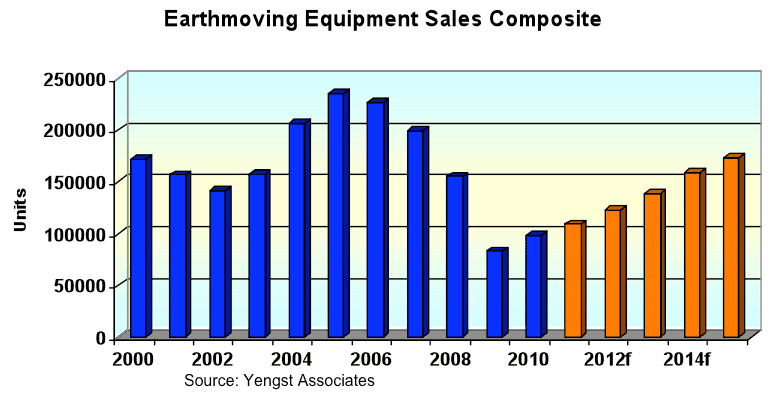The market for construction and industrial machinery, is a cyclical business, which is shown below in the chart portraying a composite of earthmoving equipment sales in North America. Our composite covers 14 different products including tracked dozers, excavators, motor graders, skid steel loaders, and wheel loaders to name a few of the products and we are showing a 10-year period with five years of projection.
We have watched the machinery industry move through one of the largest demand cycles from 2002 through 2006 and 2007 and then one of the worst sales declines in history during 2008 and 2009 dating back 50 - 60 years. A modest recovery in sales during 2010 is one positive note to the most recent very challenging years. While the graphic above does give a strong impression on what has been happening in the machinery industry over a decade in time, the same picture of strong and weak markets prevailed in most machinery product areas Ð cranes, work platforms, lift trucks, forestry equipment and paving equipment. Even the parts and components business went through a sweeping decline in sales during the height of the recent downturn as shown later in our discussion of the undercarriage business. The only product area with positive sales growth in recent years has been the agricultural equipment industry where large tractor sales and heavy farming equipment have prospered in the North American market. However, we might add that even compact small tractors used in industrial applications have had a pattern of sales trends like that shown above.
Why has the market collapsed during the past few years? Several reasons for the big swing from “boom-to-bust” can be discussed endlessly, but some of the faults lie with the over-extension of mortgage loans by banks in the housing market to home buyers that could not afford the housing they were buying; increased lines of credit to too many people without reasonable means for paying on the credit lines if employment was a factor; and of course, the economic problems associated with the global financial “melt down”.
Is there a brighter future for machinery in North America in the coming years? Yes, we believe sales will follow a continued pattern of growth through 2015, although we say this with cautious optimism. Both the U.S. and Canada have major economic problems still to be overcome. Unemployment is near 9 percent and total unemployment with people trying to find work and those that have given up looking probably ranges near 15 percent of the work force. Unemployment is a key to the future economic growth and prosperity in the marketplace and the economy is not growing fast enough to absorb the vast numbers of people out of work. We need over three percent (3%) growth in real GDP each quarter to generate new jobs and create a stronger base from which unemployment will be reduced on a permanent basis. Our economy in the U.S. is growing near three percent, but without stimulus funds is limping along near or below that level.
Housing is a serious drawback to the economic situation. Generally, housing construction helps the U.S. and Canada withdraw from recession, but in this cycle we have little in the way of new housing demand because of the huge levels of unsold houses both new and existing dwellings. Annual housing starts hit a low point of 520,000 units down from about 2 million units last seen in 2003 through 2005. We are looking for only modest improvement for single-family housing construction during the next two years and thereafter gaining strength in 2013 through 2015 to higher levels near 1 million units. Multiple family starts are needed and will be the one saving grace to the construction industry in the next few years. Total starts (single-family and multi-family) will likely range near 575,0000 units in 2011 and 675,000 in 2012, a far cry from the levels of three and four years ago.
Non-residential construction is at a 10-year low point. Highway construction is slow, but primarily oriented to maintenance at best. Bridge construction and repair is very slow. Commercial building construction is not needed as there is a glut of commercial buildings in every metro area in the U.S. and Canada and excess vacancy of office space to curtail office building out of the question for some time to come. Infrastructural construction is needed, but states, and cities are very low on capital and have serious budget problems from lower tax revenues and the slower economy in the states. Major budget cuts that we all hear about are actually taking place and that means that capital will be very tight going out several years. The list of construction projects is short and that might not come back very quickly in the next two years, perhaps longer. Electric power plants are continuing to be built, but that is a very small aspect to overall construction activity.
We see machinery sales having some recovery in 2011 and more in 2012 with the hope that the economies in both the U.S. and Canada will show some strength over time, getting more people back to work and helping to develop a more confident populace and less pessimism about future projects and growth in general. We are, however, looking at the machinery industry with much different eyes than we had four years ago. The “new normal” for tomorrow will not be the same as what we saw in years past. Demand will be slower and lower and there will be consolidation of companies in the machinery industry as there is too much capacity and too many companies involved in the business. We view the coming five years as a serious challenge to all the suppliers in the machinery business and to those supplying the axles, transmissions, engines, and components including undercarriage parts as well. Overseas business in China, India, Brazil or perhaps a few other locations will likely be more robust than what we expect for the North American market, but not to say that we are not expecting the market to grow. It will, but at a slower pace than we have been seeing for years, even decades.


























